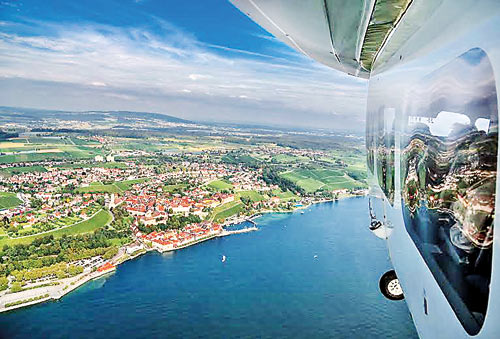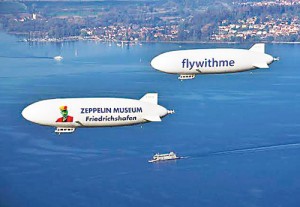Nostalgic flight into the past in a zeppelin
There was no taxiing. No waiting for a slot. There was not even a runway. Or any engine roar. Or ear-popping.
We simply floated up into the sky above Lake Constance.

Up, up and away in the zeppelin. Pic by Michael Haefner
Once, it was the only way to fly. It was the ultimate high life. Only the very rich could afford to travel the world in the belly of the Leviathan.
In 1928, the hydrogen-fuelled airship “Graf Zeppelin” carried 20 paying passengers on the first trans-Atlantic flight. A year later, with a crew of thirty-six looking after nine passengers, she completed a deluxe 12-day, 30, 831-mile world tour via New York, Los Angeles and Tokyo. The press baron, William Randolph Hearst, organised the junket. At roughly £28,000 per person. He also paid the modern equivalent of 2m for the media rights.
Before being retired in 1937, the “Graf Zeppelin”completed 590 flights including a polar expedition and two trips to the Middle East.
Her successor, the ill-fated“Hindenburg”airship was no less luxurious. She offered incomparable facilities and became the flagship for the opulent“New Germany”. A return ticket between Frankfurt and Lakehurst, New Jersey on the 242 ton airship carrying seven million cubic feet of hydrogen,cost $720 with single occupancy of one of her two-berth cabins an extra $1000. Westbound the flight took sixty-four hours. Eastbound, fifty-two.
At 245 metres long, the earliest airships were longer than three 747s put end to end.
Now, between April and November, you can fly in a modern zeppelin, taking off from the place where commercial travel all began – Friedrichshafen in southern Germany.
Flights are between thirty minutes (200 Euros) and two hours (765 Euros). There are twelve routes which take in sights like the Rhine Falls of Schafhausen and the island of Mainau. In the cockpit are the pilots , Hans Friedrich Gunther and Hans-Paul Strohle who took 30 of us over Hagnau, Meersburg and Kreuzbergen.
Then to Konstanz and the Rhine inlet. We lapped Germany’s largest lake at a speed of 35 knots or 65km per hour at an attitude of 350m , burning 90 litres of gas in the process. There was little noise or reverberation.
Below was the “Pfander” cablecar at Bregenz, the old Lighthouse and Gunpowder Tour of Lindau close to the ancient church of St Peter famous for its frescoes by Holbein the Elder.

Pic by Gerherd Plessing
Friedrichshafen’s “Zeppelin Museum” houses a reconstruction of the infamous “LZ129 Hindenburg”–named after president Paul von Hidenburg, that crashed in 1937, killing 35 people.
It might have been sabotage as the company chairman, Dr Hugo Eckener, objected to Goering using zeppelins to play marching music and to spread Nazi propaganda. The Nazi Air Minister eventually ordered the zeppelins and their hangars to be destroyed.
The luxury liner in the sky had a 15’ x 50’ dining room seating thirty-four. Its cotton-fabric walls were covered with paintings of landmarks like Rio’s Sugar Loaf Mountain. There was white linen, fresh-cut flowers, silver cutlery and porcelain china tea sets. Gourmet lunches consisted of fattened duck Bavarian style with champagne cabbage and Madeira gravy. Dinner comprised grilled sole, venison cutlets and cheese board. Wines were from the Rhine and Moselle. French red was also available. There was a writing room and library. Telegrams could be sent from the radio room. The “Hindenburg” had a crew of fifty, mostly ex-seamen.
There were daily tours over the catwalks to see the spare engine and four-blade wooden propeller, the sixteen giant gas cells, the gondola and control room.
The airship had a 50’ promenade and in-flight entertainment revolved around a baby grand piano made from weight-reducing pigskin. The electric kitchen stored 5500 pounds of food and 40 gallons of milk. Fresh bread was baked daily. There was one shower bath on board which gained a reputation for its “miserly output” and had, according to contemporary reports,“the habit of suddenly cutting out”.
The bar served frosted cocktails and smoking was only allowed in the designated smoking-room ( “where the cheery souls stayed”) . Only the attendant was allowed to operate the airship’s official cigarette lighter.
Photographs were only allowed over the ocean. The zeppelin even had a sick bay. The resident doctor was one of the few to survive the crash which took the life of the Graz Zeppelin’s captain.
Cabins were small and spartan, furnished with a foldaway cot bed with a German puff blanket and quilt eiderdown, a folding wash basin with hot and cold running water , a mirror and a wardrobe which “held a half a dozen suits” . Each passenger was allowed 44lbs in personal luggage. Guests were requested not to throw objects out of the window.
“Vorarlberger Land” and the skies above Friedrichshafen are the birthplace of long haul air travel. The international aviation industry was born in Lake Constance. Thanks largely to one larger-than-life man whose statue stands beside the lake.
Count Ferdinand Adolf August Heinrich von Zeppelin, a cavalry general and diplomat who died in 1917 and is buried in Stuttgart , first flew a zeppelin in 1900 from pontoons moored off the Bay of Manzell in Lake Constance. This was three years before the Wright brothers flew their heavier-than-air plane at Kitty Hawk. Two hundred locals had to hold the aircraft down before take-off and then pull it in on landing. And then anchor it.
Having first seen balloons during the Siege of Paris in the Franco-Prussian War, Zeppelin bought a design off Croatian inventor, David Schwarz and patented it as “a steerable all-cruising train”. The first lighter-than-air flight lasted eighteen minutes, being curtailed by “technical difficulties.” The cloth-covered prototype was 128 metres long and powered by “Daimler” engines.
One hundred and seventeen airships or “dirigibles” eventually came off the production line. The first airships were used for surveillance and bombing raids during the First World War. Friedrichshafen became the cradle for German industrial history.
Altogether nearly six hundred commercial zeppelin flights were made covering 1.7 million miles. Some artefacts from these momentous events in civil aviation history can be seen at the museum, formerly the harbour railway station. Entry is 8 Euros. On display are blueprints, engine parts, original ticket stubs,commemorative coins and stamps, posters, menus, cutlery and crockery used on the VIP flights.
“Helium is now used in modern airships as well as rigid aluminium rings and girders and high-strength multi-layer laminate fabrics, “ laughed my guide. “Rather than the skin from cow’s appendixes!”
The last zeppelin airship produced in Friedrichshafen was the “Graf Zeppelin 11” which entered service in 1938. No zeppelins were built for the next 59 years.
The first modern zeppelin was launched in September 1997. There are two airships ( “Bodensee” and “Baden-Wurtetemberg”)in the current fleet..
Twelve thousand people have gone up in the zeppelins over the last five years. Flights are also available from Munich’s Schleissheim airport. Tickets cost E315.
Lake Constance has 173 kilometres of German shoreline, 72kms of Swiss and 28 of Austrian. All visible from the air.
The giant gasbag moved silently over the landscape of the “Swabian Sea”. Passing above orchards, hop fields, castles, convents, marshlands, fishing and sailing boats , windsurfers and campsites. And the UNESCO World Heritage site of Reichenau.
From Friedrichshafen you can explore the lakeside towns of Uberlingen, Langenargen with its Moorish Montfort palace, Wasserburg and Bad Schachen.
In Constanz you can walk the medieval Kreuzlingerstrasse and see the old tanners’ quarters and linen weavers’ guildhouse (ZurSalazscheibe), Obermarkt Square with its Hotel Barbarossa (named after Peace of Constance 1183 ) , the thirteenth century city gates and Tettikofer Hof Palace. “The Tall House” dates to 1294.
Most of Friedrichshafen, formerly the imperial township of Buchhorn, was destroyed in the Second World War. The hub of technology, it was also the test base for torpedoes and radar.
We came down as gently as we had gone up. There was no screeching of brakes. No bumps.
Every flight from Friedrichshafen is a nostalgic flight into the past. You fly back in time with all the comforts and mod-cons.


